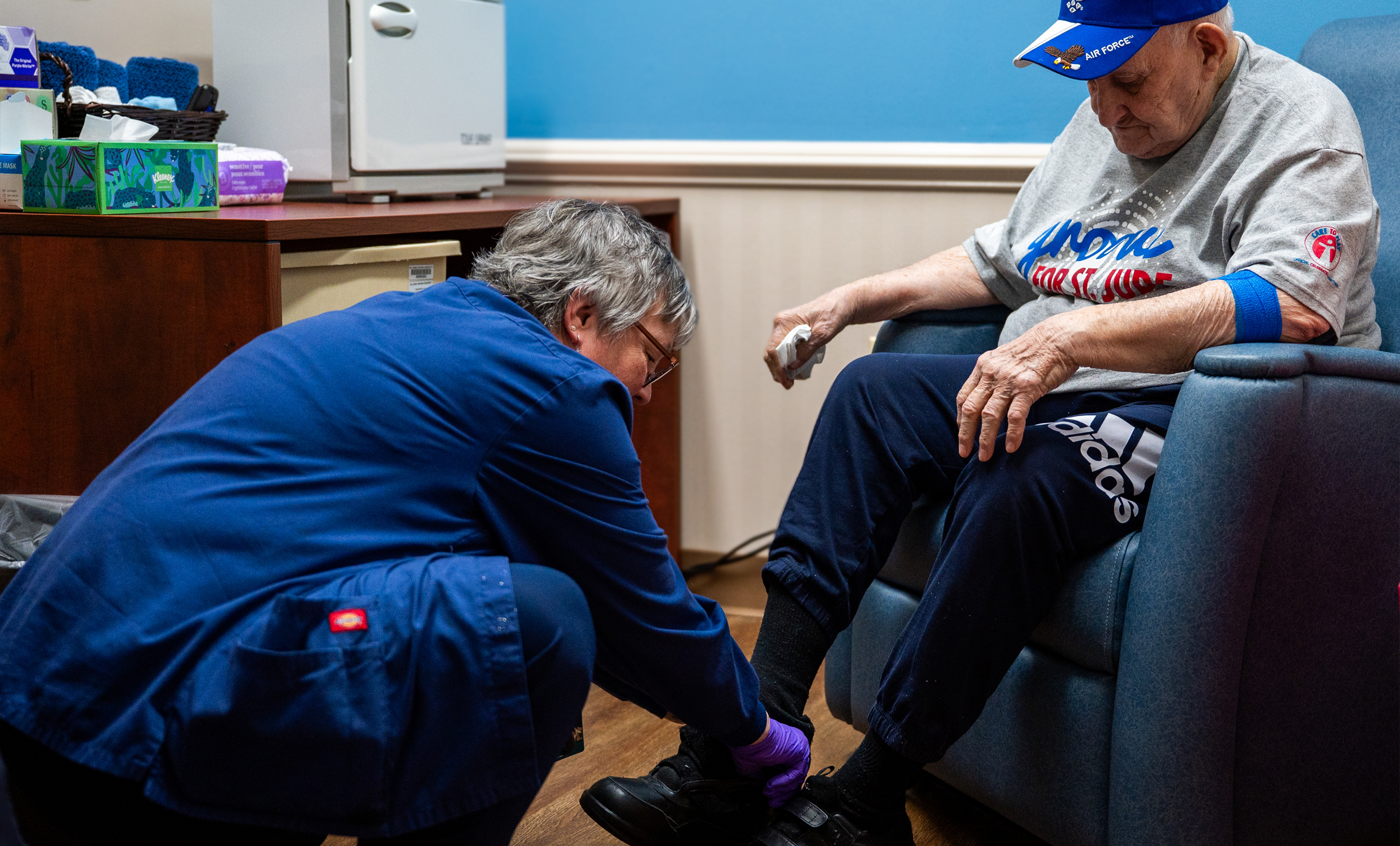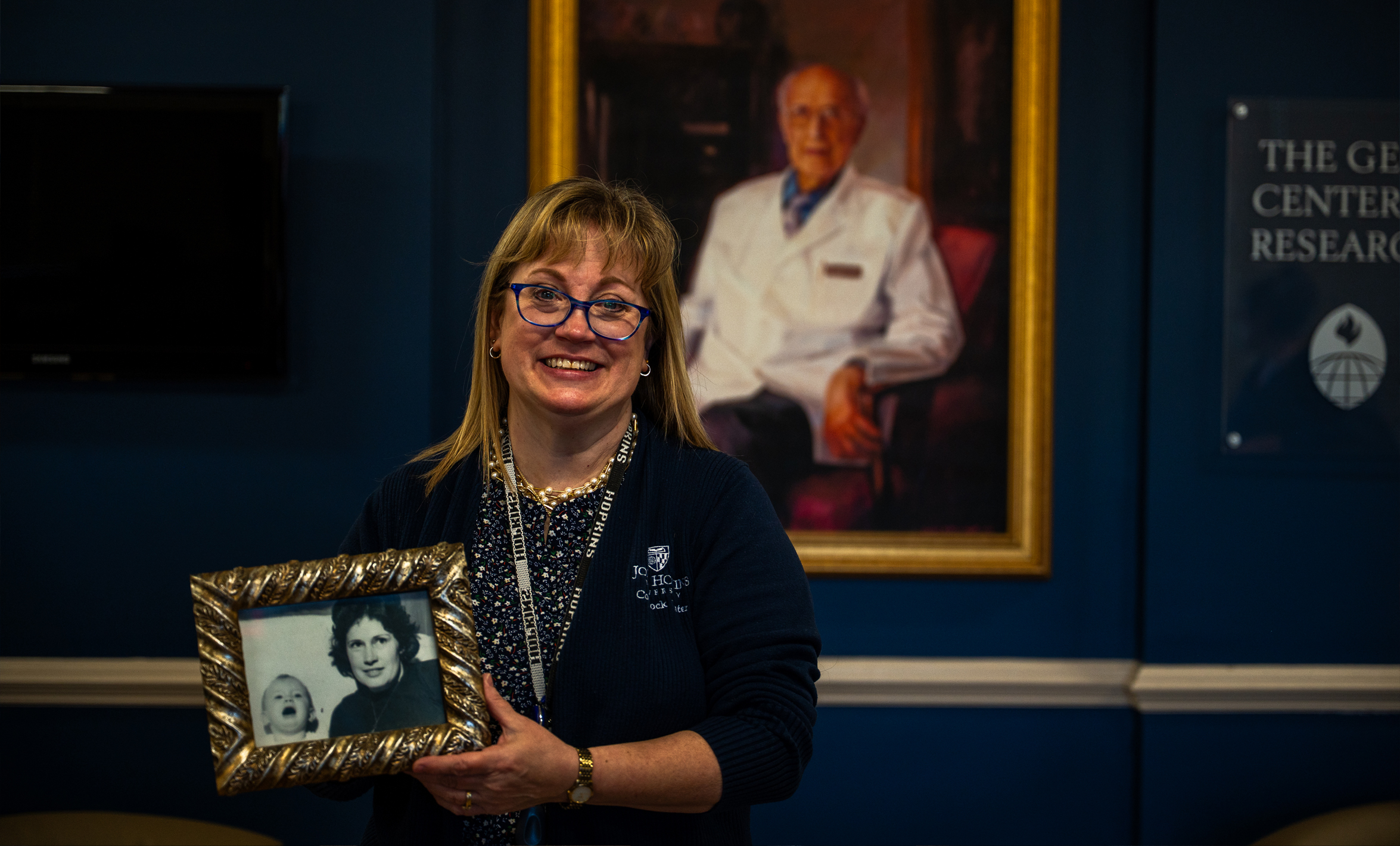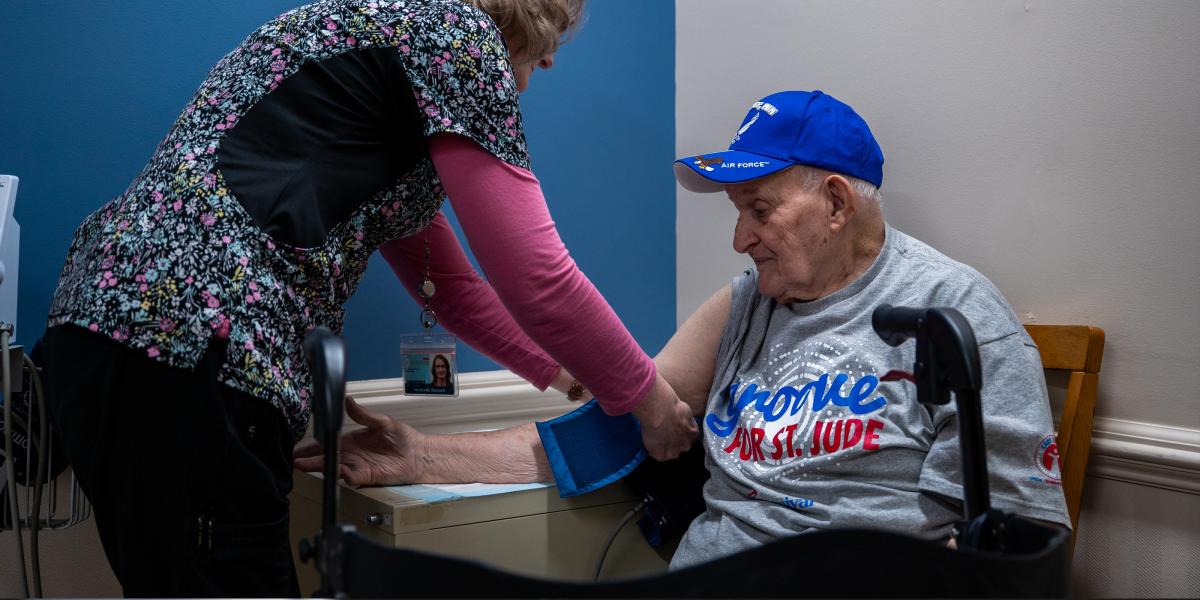Research With Heart: The ARIC Study
Community bonds and a human touch have helped scientists collect some of the world's best population-based data on cardiovascular disease risk.
Frank Squibb opens the passenger-side door of the cherry-red SUV and eases out. His girlfriend of 18 years brings over his walker, and a staff member helps Frank alight. Nowadays, his girlfriend or his oldest daughter drives Squibb, 85, wherever he needs to go. When he first signed up for this, at age 50, he could maneuver easily; but the decades and diagnoses have slowed him down.
Squibb walks through the clinic doors and, soon enough, he’ll roll up his sleeve for the blood pressure cuff and the blood draws. He’ll talk about his recent medical history and show a technician every medication he’s taken in the past four weeks. But this isn’t a doctor’s visit. Squibb is one of more than 4,000 participants at the Hagerstown, Maryland, location of the Atherosclerosis Risk in Communities (ARIC) Study, which first began studying heart disease in 1987 and eventually expanded to focus on cognition and other aging-related conditions. It has collected some of the best population-based data in the world on the risk factors for heart disease, as well as essential data on health disparities in cardiovascular disease, and risk factors for diabetes, kidney disease, heart failure, and dementia.
Hagerstown and the three other study sites—in Jackson, Mississippi; Minneapolis, Minnesota; and Forsyth County, North Carolina—had about 16,000 participants in total, with the work supported by the NIH. More than 3,000 research papers have drawn upon this data to improve health care and reduce cardiovascular mortality, with breakthrough discoveries like the impact statins and other drugs have on cholesterol levels and cardiovascular risk, or the ways heart disease risk factors in middle age affect brain changes related to Alzheimer’s disease. In particular, ARIC has shown that preventing and treating chronic diseases such as high blood pressure and diabetes as early as possible is key to preventing the progression of these illnesses.
“You can’t really understand risk factors for long-term outcomes unless you follow people for 20 or 30 years, so it’s really an extraordinary study,” says Epidemiology Professor Elizabeth Selvin, PhD ’04, MPH, interim director of the George W. Comstock Center for Public Health Research and Prevention, where the Hagerstown ARIC study takes place. The Hagerstown site “sets the standard for rigorous data collection,” Selvin says. The study follows in the footsteps of the Framingham Heart Study, the landmark study of cardiovascular health and aging that began in 1948 in Framingham, Massachusetts. But ARIC has a more diverse cohort, drawing on four different rural and urban communities across the country, and it focuses on subclinical disease as well—not just heart attacks and strokes.
Squibb joined in 1989. He’s one of about 978 people still actively participating in the study. “My brother was in it, and he talked me into it. He said, ‘You ought to try. They do a lot of good stuff,’” Squibb says.
“You can’t really understand risk factors for long-term outcomes unless you follow people for 20 or 30 years, so it’s really an extraordinary study."
A veteran who served in the U.S. Air Force from 1959 to 1963, he sees his doctors at Veterans Affairs every six months, unless there’s a problem. He likes the idea of another set of eyes on him, another pair of hands taking his vitals. Even though the ARIC technicians can’t offer medical advice or make diagnoses, participants—and their physicians, if they choose—get summaries of their lab results and other tests.
“And I like everybody,” says Squibb, his blue eyes as sharp as his sense of humor. “Everybody treats you good here.”
Mary Morton, the technician taking Squibb’s vitals, beams. “I love meeting all these interesting people. Every day is a different day,” she says.
She and Squibb chat about cruises and grandkids—he has 12 grandkids and 21 great-grandkids in all. Squibb donates to St. Jude’s and Shriner’s Hospital a few times a year. This is the only part of the visit where he gets a little emotional. He knows how hard it is to have cancer—he had stage 3 colon cancer and stage 4 liver cancer—and he can’t imagine a baby going through that, he says. A Hagerstown native, he retired from his security-guard job in December 2022. He’s been dating his girlfriend since 2007; they go out to dinner and play bingo. She’s a good companion, he says.
While they talk, Morton pays careful attention to Squibb’s comfort—is this chair too hard on his painful hip? Does he need help moving from one place to the next, because of the neuropathy making his feet tingle and blaze? After she checks his feet for swelling, she kneels and carefully puts his socks and shoes back on.
In clinical studies, each person is a data point. But at the Comstock Center, researchers and technicians work hard to keep sight of the people, even as they collect the data. They keep waffle-knit robes and heated towels on hand for when participants need to disrobe. “We want almost a spa feeling when you come here,” says Melissa Minotti, MPH, operations director of the Comstock Center. “There’s a sense of comfort, a sense of ease that they have coming here.” The staff also do home visits, including in nursing homes, and offer transportation.
“They have lots and lots of doctor’s appointments—and we don’t want this to feel like just another doctor’s appointment,” says Amanda Reed, clinic supervisor. “We wouldn’t be here without them.”
“Any little thing we can do to help them enjoy their visit here helps with our retention,” says Spencer Bolton, another clinic supervisor. “With every touch, we have this opportunity to influence the future with them.”
The study participants also feel like they are part of something bigger—an act of community in every visit. “Our participants are vested in this study. They want to see it succeed,” Minotti says. Technicians were able to complete a visit with one participant in the advanced dementia unit of a nursing home, because her daughter knew her mother wanted to contribute to the research until the very end.
Caught between the Blue Ridge and Allegheny Mountains in the heart of the Great Appalachian Valley, Hagerstown feels quintessentially American. It is a small town about 70 miles north of Washington, D.C., with a population of about 43,000, in western Maryland’s narrow panhandle.
Small towns like these don’t usually have reputations as scientific meccas. But this study is a model not just for conducting research, but for “maintaining—and even strengthening—scientific trust in a rural community,” Selvin says. Many of the staff grew up in Hagerstown, participate in community events, and have existing relationships with participants.
The Hagerstown study shows the value of “big-world data, but small-town values,” says Minotti.

Morton is running a measuring tape down Squibb’s arm and asking about his weight, jotting down notes in an exam room that is standardized across all four field sites so nothing might affect participants’ cognitive tests, like visible clocks or calendars.
“Our data is good because we’re consistent,” says Stephanie Bussard, another of the technicians working with Squibb.
Between 1986 and 1989, a total of 4,020 people ages 45 to 64 joined the Hagerstown ARIC study. For the first 12 years, they came in for checkups every three years. Then, as funding dried up, there was a long break (except for one short study) until the main study resumed in 2011. In the past 10 years, participants have come in nearly every year.
Even when visits paused, the staff stayed in touch. “We called them every year for the last 40 years,” Minotti says. Now, they call twice a year to ask health questions: Have you had any hospitalizations? Have you had any illnesses? Do you have any life changes or anything new to report? The technicians then follow up on every hospitalization and every death to understand how they might relate to aging and cardiovascular health.
“There’s so many changes that have happened with these participants, from, say, a median age of 50 to now 85—that’s the real meat and potatoes of aging,” Minotti says. “And we’ve seen them do that. We’ve been with them through that.”
ARIC first focused on cardiovascular disease and stroke. Researchers wanted to know what factors led to heart disease, what might help stop it, and who was at risk. The researchers widened their scope in 2011 to look at dementia, cognitive decline, and other aspects of aging: grip strength, walking speed, balance—performance measurements that relate to frailty and reveal how a person is physically aging.
“It’s truly one of the most important studies of cardiovascular disease in the country, and now one of the most important studies of cognitive decline and dementia,” Selvin says.
Selvin, now ARIC’s principal investigator for the Hagerstown site, first got involved as a PhD student two decades ago. Instead of looking at cardiovascular health, she focused on hemoglobin A1C as a biomarker for diabetes.
“That work was central in informing changes to how we screen and diagnose diabetes and prediabetes,” she says. The study was published in the New England Journal of Medicine in 2010, and the American Diabetes Association changed its guidelines to make hemoglobin A1C a way to diagnose diabetes and identify prediabetes, as did the WHO and health organizations across the world. Her diabetes work continues in the ARIC study, since diabetes affects cardiovascular health and is an important risk factor for dementia and cognitive decline.
Recently, researchers at Comstock and other ARIC centers did the first new enrollment of participants since the ARIC study’s early years. It was for a new study led by Selvin called ARIC Generation 2, focused on type 2 diabetes. Participants in the original ARIC study have worn electrocardiogram trackers and continuous glucose monitors to track whether very low or very high glucose triggers cardiac arrhythmias. This new iteration of the study adds younger participants ages 50 to 80—some of them have family members in the original ARIC study.

Perhaps no one is more obsessed with what this study means for the community than Melissa Minotti. She thinks about everything with an astonishing level of detail. The lobby, for example, offers wide, comfortable couches and a coffee table spread with magazines and recipe books from local churches and organizations. (Participants love to scour them for familiar names and dinner ideas.) The snack bar is stocked with beverages and food—including ARIC-branded chocolates made by women recovering from substance use through a local organization, Brooke’s House.
The participants and staff have their own lunchrooms so they can relax, and there are picnic tables out back for nice days. Instead of lunch from a chain restaurant, the team orders sandwiches and salads from Safron Bakery, a local business around the corner.
Staff send participants cards marking birthdays and holidays, the losses of loved ones and beloved pets, and recoveries after illnesses and hospitalizations. When a participant turned 100 a few months ago, the staff brought her flowers and celebrated with her.
For Minotti, everything comes back to the community. She grew up in Hagerstown and has family in the area dating back hundreds of years. In her office, she has a photo of herself as a baby with her mother.
Her mother is the reason Minotti is here at the Comstock Center. Her mom was an ARIC participant who also worked as a recruiter and technician at the center. Minotti began working alongside her more than 33 years ago, rising up the ranks from receptionist to operations director and earning her master’s in public health along the way.
She debated getting her degree, wondering if it was worth it if she wasn’t “going somewhere, to another country to help them get clean water or something like that,” as she told her husband. “But these are your people here,” he responded. “Don’t they deserve as much of your care and investment in public health as anywhere else in the world?”
That’s how George Comstock, the legendary epidemiologist and founder of the center, approached his work. He lived in Hagerstown for decades and “believed that if you live in a community, you can study it better than if you lived somewhere else,” Minotti says. “It gave you an intimacy and an understanding of the community that you wouldn’t have otherwise. And I think that it’s brilliant.”
That approach is at the heart of the ARIC study. “I can look at the roster of the participants, and I can go: my mother, my second-grade teacher, my next-door neighbor, my first boyfriend’s mother,” Minotti says. “This is my community.”
People in Hagerstown tend to have what she calls a “peripheral Appalachian mindset—a peculiar paradox of individual initiative and community support,” Minotti says. They rely on themselves, but when hard times hit, they know they have a warm and supportive community behind them. “And I understand that—I was raised with it,” Minotti says. “Our staff understands this community, because most of us are from here.”
One recruiter, Kathleen Hunt, has been with ARIC from the beginning, and participants recognize her when she calls. At 81, she is one of their peers. “She can speak to them on a level that even I can’t,” Minotti says. “She is going through the changes that they are, also.”
Participants started between the ages of 45 and 64 when they were in the middle of life, raising families, working, and buying houses. Now, they are between 80 and 102. “We’ve seen them, in the last 30-some years, change,” Minotti says. “Some of them have great-grandchildren. They’ve experienced the loss of family, the loss of spouses, the loss of mobility.
“We’re seeing them at the end of their life,” Minotti says. “What we’ve found is we have to be nimble to be able to change with them.”

Toward the end of his four-hour visit, after an echocardiogram tracks the beat and flow of his heart, Squibb shuffles back into the changing room, with Morton at his side. Their voices seep through the closed door—Squibb’s rumble of gratitude, too low to catch the particulars, and then Morton’s: “I think it’s one of my gifts—the gift of helping people.”
Then, Squibb pushes his walker on a four-meter timed walk. “Good job. Now, do you have enough strength to go back?” Morton asks. He says yes, and turns around for the return walk. “Lunch time, you’ve earned it,” she tells him.
Over lunch, Squibb returns to the topic of his brother, and how he convinced him to join the trial. “He told me everything that they were doing for him. So I thought, Well, why not?” Squibb contemplates his sandwich. “And he said you get a free lunch.”
Jokes aside, there’s no artifice to Squibb; if he says he’ll do something, he does it. Simple as that. “I’ve been doing it now for 35 years,” he says. “Why stop? You know, until you can’t do it anymore.”
